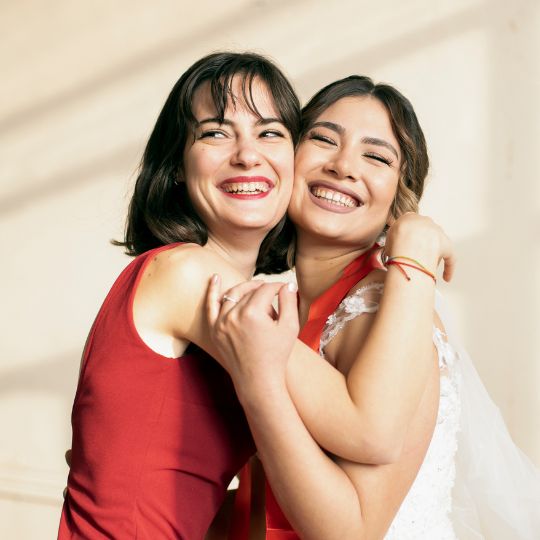Including Your Sisters
and Besties in Your Wedding Ceremony
Categories: | Inclusive Weddings | Wedding Ceremony |
 What
is the most difficult decision to make when it comes
to planning your wedding? Not where, when, or how
much you can afford to spend, though they are
important decisions that are never easy to make.
What
is the most difficult decision to make when it comes
to planning your wedding? Not where, when, or how
much you can afford to spend, though they are
important decisions that are never easy to make. The most difficult decision is who to share the day with. Your guest list, and who to involve in the ceremony. Unless you are an only child it has to be how to involve your siblings.
It is pretty well expected that a bride will include all of her sisters in her wedding party, or that a groom's sister(s) will stand up with the bride. Nobody knows you as well as your sister(s). So, how do you solve the dilemma of having more sisters than will fit your vision (or your budget) for your wedding party.
When you add close friends to the mix, it becomes even more difficult because you will need to navigate several highly emotional issues at the same time.
- Each of these people are important to you, so it is a challenge to find a solution that doesn't scream favouritism or damage your relationship with any of them.
- You will likely have to deal with emotional blackmail,. This may come directly from the individuals concerned, but it is also highly likely that it will come from others speaking on their behalf.
- You will feel obligated and beleagured
Say no to a gendered
wedding party
Your legal witness
Flower Ladies(s)
Part of the Processional
trust
You could expand your processional to include the whole group of your sisters and besties. They don't have to dress alike. They don't have to stand up with your. They can all throw petals and get up to hi-jinks in the manner of flower-dudes. Reserve seats near the front so they can sit down. But after they have greeted the person waiting to marry you! Makes great photos and starts the ceremony on a real high.
Hand over your bouquet
Ceremony reader
Ring Bearer / Presenter
of the Rings
Participant in a ritual
Some examples:
- Wine blending ceremony, in which
wine is shared by the marrying couple
- Handfasting
- Sandceremony - as an
invented tradition it can be adapted to
include anyone you want to include and mean
anything you want it to mean. Use something
other than coloured sand. Anything that mixes.
I've had petals, gravel, M & M's,
etc. Involve all of your besties, give each a
different colour, decide what these colours
will represent (what they bring to your
friendship, is one possibility, another is the
qualities they have that will support your
marriage), and at the appropriate time, have
them come forward to pour their sand.
- Unity Candle - for example, turn this
ritual on its head to make a visual statement
about supporting your marriage by choosing
selected people to light the individual
candles and then, together, light the central
candle.
- Warming of the rings
The person who asks the
Affirmation of Intention question
Musician or Singer
The officiant
Allocating roles without
causing friction
Pulling names out of the hat is something everyone in Australia understands. And it works brilliantly when you have to choose one or two people from a larger group.
When you need to allocate differing roles among a defined number of people, a slightly different take is required. Put the roles in the hat and let your people each pick one. Simple! You are hands-off, and no-one can manipulate it, or imagine that the process has been manipulated.
Fun variations on the roles in the hat method are some that work really well
- Choccie or cupcakes lottery
- Bubbles or Shots lottery
- Doctored pack of cards
Get all of your BFFs and siblings together and
set out the exact number of wraped
choccies/cupcakes/glasses as there are people
vying for a role in your wedding.
For the cupcakes, carefully insert a tightly
rolled piece of paper, on which you have written
a specific role, into the cupcake. You can roll
the slip of paper round a toothpick. insert, and
then remove the toothpick leaving the paper
behind - just make sure there is a little
sticking out at the top so it doesn't get
swallowed by mistake!
Under the choccies or glasses, stick a label on
which you have written a role. Let everyone
choose their own choccie or glass, and that's
their role. If there is any possibility that
anyone will take a sneak peak, just put a letter
of the alphabet or a number on the label, and
have a prepared list of what role each
letter/number represents. To further make sure
that, even if someone has a sneaky peak, nobody
can use that knowledge to their advantage, don't
pick the obvious consecutive numbers/letters
starting at 1 or A, pick random ones.
For the doctored pack of cards, write the
relevant number on the face of the pack of
cards. Shuffle them and get someone who isn't a
candidate (great role for a grandma who still
plays cards with physical cards) to shuffle the
pack, get each person to cut it, and shuffle
again, and then deal each person a card face
down. The big reveal makes for great photos as
each is told what the role is.
Related posts
Thanks for reading!
